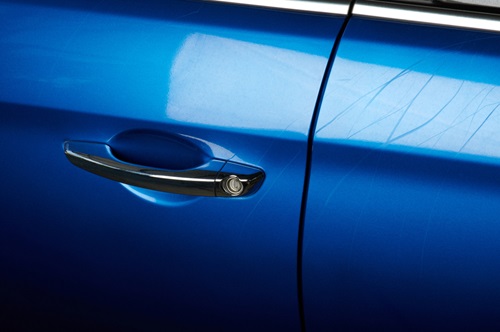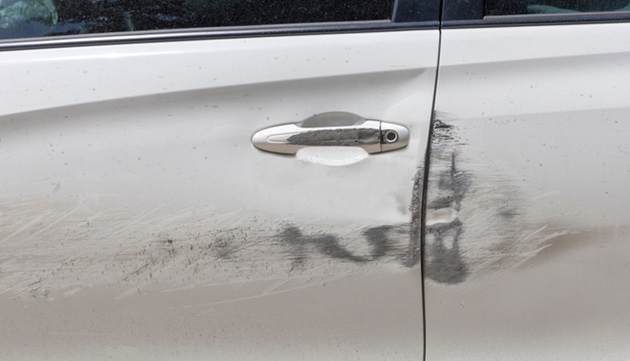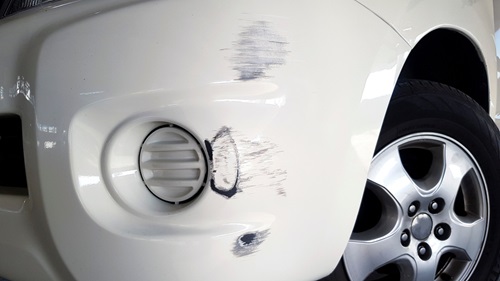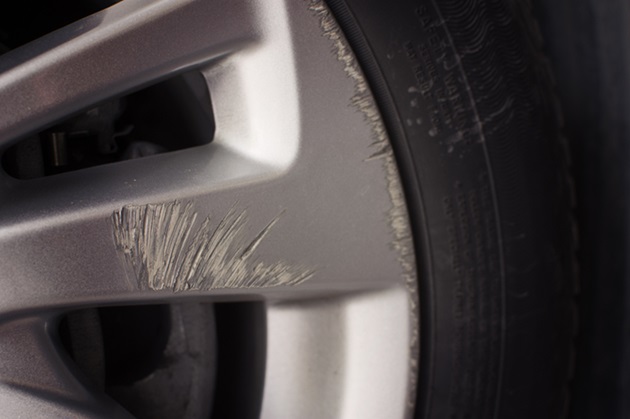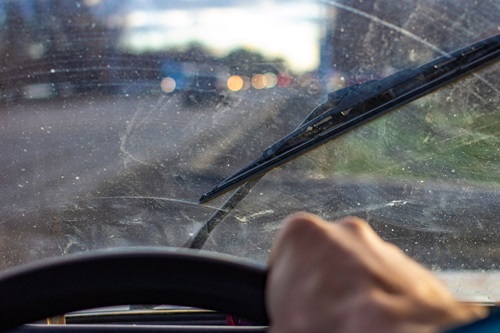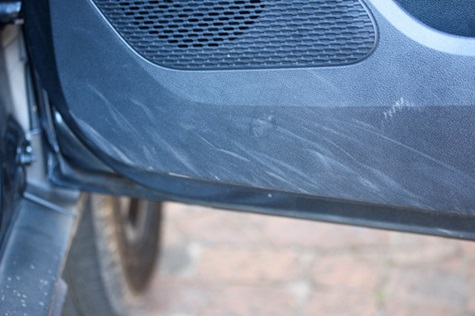If you’ve ever owned a car, chances are you’ve encountered those pesky scratches that seem to appear out of nowhere. Whether it’s a tiny surface blemish or a deep gouge, dealing with car scratches can be a real headache. But fear not, because in this article, we’re diving deep into the world of automotive aesthetics. We’ll explore the different types of car scratches, from the faintest hairline marks to those nasty, paint-damaging scrapes, and we’ll arm you with the knowledge and techniques to tackle them head-on. So, if you’re ready to learn how to make your beloved ride look as good as new, stick around and let’s get those scratches sorted!
Outline
Toggle- How Do Cars Get Scratched?
- Most Common Types of Car Scratches
- Other Types of Car Scratches
- What is the Difference Between Scuff and Scratch?
- How to Fix Scratches on a Car?
- Don’t Delay Dealing With Car Scratch Repair
- How Much Does it Cost to Get the Scratch Out of Your Car?
- Different Types of Car Scratches – FAQ
- Conclusion
How Do Cars Get Scratched?
- Contact with abrasive materials like rocks, gravel, or sand while driving.
- Accidental impacts with shopping carts, doors, or other objects.
- Brushing against overgrown vegetation or tree branches.
- Poor washing techniques using abrasive sponges or brushes.
- Vandalism or deliberate scratching by individuals.
- Exposure to environmental factors like bird droppings, tree sap, or harsh weather conditions.
- Poorly maintained automatic car washes with abrasive brushes.
- Rubbing against walls or pillars in tight parking spaces.
- Accumulation of dirt and debris on the car’s surface.
Most Common Types of Car Scratches
1. Clear Coat Scratch
- Description: Clear coat scratches are the most frequent type of surface scratches on cars. They affect the top layer of paint, known as the clear coat, which serves as a protective barrier for the underlying paint layers.
- Causes: Clear coat scratches can result from minor abrasions such as brushing against bushes, rubbing against other vehicles, or using rough cleaning materials.
- Appearance: These scratches often appear as thin, shallow lines on the car’s surface, and they typically do not penetrate the paint layers beneath the clear coat.
- Repair: Clear coat scratches are relatively easy to fix. You can often remove them by using polishing compounds or scratch removal kits. For deeper scratches, professional detailing or repainting may be necessary.
2. Base Coat (Paint) Scratch
- Description: Base coat scratches go deeper than clear coat scratches and affect the layer of paint directly beneath the clear coat. This layer gives your car its color.
- Causes: These scratches can result from more substantial impacts, such as collisions, accidents, or sharp objects scraping against the car’s surface.
- Appearance: Base coat scratches are often more visible than clear coat scratches, as they expose the colored layer underneath. They may appear as lines or irregular patches of exposed paint.
- Repair: Repairing base coat scratches involves filling in the damaged area with touch-up paint, sanding it down, and then applying clear coat to restore the finish. For extensive damage, professional painting may be necessary.
3. Primer Scratch
- Description: Primer scratches are the most severe type of scratches, as they penetrate through both the clear coat and the base coat, reaching the primer layer beneath.
- Causes: These scratches usually occur in high-impact situations, such as collisions, accidents, or significant scrapes against hard objects.
- Appearance: Primer scratches expose the primer layer, which is typically gray or light-colored. They appear as deep gouges or areas where the paint has been completely removed.
- Repair: Repairing primer scratches is a more complex process. It involves filling the damaged area with primer, applying base coat and clear coat layers, and then sanding and polishing to blend the repair with the surrounding paint. This repair is often best left to professional auto body shops.
Understanding these common types of car scratches will help you assess the damage to your vehicle and determine the appropriate repair methods. Whether you’re dealing with minor clear coat scratches or more severe base coat or primer scratches, addressing them promptly can help maintain your car’s appearance and protect it from further deterioration.
Other Types of Car Scratches
1. Wheel Scratch (Curb Rash)
- Description: Wheel scratches, often referred to as “curb rash,” occur on the rims of your car’s wheels. They are a common issue, especially when parking close to curbs or in tight spaces.
- Causes: Curb rash typically results from the wheel making contact with curbs, sidewalks, or other hard obstacles while parking or maneuvering. It can also happen during tire replacement if not handled carefully.
- Appearance: Wheel scratches manifest as visible scrapes or gouges on the wheel’s rim. They can vary in depth and severity, with some scratches only affecting the wheel’s protective finish, while others go deeper into the metal.
- Repair: Repairing wheel scratches involves sanding down the damaged area, filling in any deep gouges with filler, and refinishing the wheel with paint or a clear coat. For severe damage, professional wheel refinishing services may be necessary.
2. Glass Scratch
- Description: Glass scratches are defects that affect the windows, windshield, or rear glass of the car. These scratches can impair visibility and compromise safety.
- Causes: Glass scratches can occur from contact with abrasive materials, such as sand, dirt, or debris, as well as from the use of improper cleaning techniques or wiper blades with debris caught in them.
- Appearance: Depending on their severity, glass scratches may appear as fine, faint lines or as more pronounced streaks or gouges. They can distort your view and create glare when driving at night.
- Repair: Repairing glass scratches can be challenging. Minor scratches may be treatable with glass polishing compounds, while deeper scratches may require professional glass repair or replacement.
3. Plastic Trim Scratch
- Description: Plastic trim scratches affect the plastic components and moldings on your car’s exterior, such as bumpers, side mirrors, and trim pieces. These scratches can be unsightly and diminish the overall appearance of your vehicle.
- Causes: Plastic trim scratches can result from various sources, including minor collisions, contact with objects, overzealous cleaning with abrasive materials, and exposure to harsh environmental conditions.
- Appearance: These scratches often appear as visible marks or scuffs on the plastic trim, and they may expose the underlying plastic material or create discolored areas.
- Repair: Repairing plastic trim scratches involves cleaning the area, sanding down the damaged surface, applying plastic adhesion promoter, and then painting or refinishing the plastic trim to match the surrounding area. For extensive damage, it may be best to seek professional auto body services.
Understanding and addressing these different types of car scratches is essential for maintaining your vehicle’s aesthetics and ensuring its longevity. Regular maintenance, careful driving, and appropriate repair techniques can help keep your car looking its best.
What is the Difference Between Scuff and Scratch?
The terms “scuff” and “scratch” are often used to describe different types of damage to surfaces, including those on cars. While they both involve some form of abrasion or damage, there are distinct differences between the two:
Scratch
- Depth: A scratch typically penetrates the surface of the material it affects. In the context of a car, a scratch on the paint, for example, will usually create a groove or furrow in the paint, exposing the layers beneath, such as the clear coat, base coat, or primer.
- Shape: Scratches can vary in shape but often appear as lines or elongated marks on the surface. They can be long or short, shallow or deep, depending on the severity.
- Cause: Scratches are usually caused by a hard, sharp object coming into contact with the surface. Common examples include keys, rocks, or abrasive materials.
Scuff
- Depth: A scuff is typically shallower than a scratch. It doesn’t penetrate as deeply into the material and may not expose the layers beneath.
- Shape: Scuffs often appear as more diffuse or broad marks on the surface. They can be irregular in shape and lack the defined linearity of scratches.
- Cause: Scuffs are often caused by friction or rubbing between two surfaces. For example, a scuff mark on a car’s bumper might result from a gentle impact with another vehicle’s bumper, where the paint rubs off onto the car’s surface.
In summary, the key difference between a scratch and a scuff lies in their depth and appearance. A scratch is typically deeper and creates a groove or exposed layers, while a scuff is shallower and often appears as a more diffuse mark resulting from friction or rubbing. Understanding this difference can be helpful when assessing and addressing damage to various surfaces, including those on your car.
How to Fix Scratches on a Car?
Fixing scratches on a car can help maintain its appearance and prevent further damage. Here’s a detailed guide on how to repair scratches on your vehicle:
Materials and Tools You’ll Need
- Car wash soap
- Clean, soft microfiber towels
- Scratch removal product or rubbing compound
- Touch-up paint (for deep scratches)
- Clear coat or wax
- Sandpaper (various grits)
- Polishing compound
- Dual-action orbital polisher (optional)
- Paintbrush (for touch-up paint)
- Painter’s tape (for masking)
- Gloves and safety glasses (for safety)
Step-by-Step Guide
1. Clean the Area:
Begin by washing the scratched area with car wash soap and water to remove any dirt or debris. Rinse thoroughly and pat dry with a clean, soft microfiber towel.
2. Assess the Scratch:
Carefully examine the scratch to determine its depth. Run your fingernail across it; if your nail doesn’t catch, it’s likely a clear coat scratch. Deeper scratches that catch your nail may require more extensive repair.
3. Use Scratch Removal Product (For Clear Coat Scratches):
- For clear coat scratches, apply a scratch removal product or rubbing compound to a clean microfiber cloth.
- Gently rub the product onto the scratch in a back-and-forth motion. Use light to moderate pressure.
- Keep wiping until the scratch becomes less visible or disappears. Be patient; this may take some time.
4. Touch-Up Paint (For Deeper Scratches):
- For deeper scratches that penetrate the base coat, you’ll need touch-up paint that matches your car’s color.
- Clean the area around the scratch and apply painter’s tape to mask off the unaffected areas.
- Carefully apply the touch-up paint using a small brush. Fill in the scratch with a smooth, even coat.
- Allow the paint to dry according to the manufacturer’s instructions.
5. Sanding (For Deep Scratches):
- If the scratch is still visible after the touch-up paint dries, you may need to sand it down.
- Wet a piece of fine-grit sandpaper (e.g., 2000 grit) and gently sand the area, keeping it wet to avoid excessive heat buildup.
- Gradually switch to finer grits (e.g., 3000 grit) until the surface is smooth and level with the surrounding paint.
6. Polishing (For All Scratches):
- Apply a polishing compound to a clean microfiber cloth and buff the repaired area in a circular motion until the surface is smooth and shiny.
- For faster and more effective results, you can use a dual-action orbital polisher.
7. Apply Clear Coat (Optional):
- If you used touch-up paint, apply a clear coat over the repaired area to protect the paint and achieve a seamless finish.
- Allow the clear coat to dry and cure according to the manufacturer’s instructions.
8. Final Touches:
After the repair is complete, wash and wax the entire car to ensure a consistent finish and blend any slight variations in shine.
Remember, the effectiveness of these steps may vary depending on the severity and location of the scratch. Deep or extensive damage may require professional auto body repair. Additionally, always wear safety gear and follow product instructions for the best results and safety.
Don’t Delay Dealing With Car Scratch Repair
Dealing with car scratch repair promptly is crucial for preserving your vehicle’s appearance and preventing further damage. Even seemingly minor scratches can expose your car’s paint to rust-inducing moisture and environmental contaminants. If left untreated, scratches can worsen over time, becoming more extensive and costly to fix. Moreover, addressing scratches early not only maintains the aesthetic appeal of your car but also helps retain its resale value. So, whether it’s a clear coat scratch or a deeper one, taking immediate action with proper repair techniques ensures your vehicle stays in top shape and avoids more extensive and expensive repairs down the road.
How Much Does it Cost to Get the Scratch Out of Your Car?
The cost to remove a scratch from your car can vary widely depending on several factors, including the depth and severity of the scratch, the type of paint and finish on your vehicle, and whether you choose to do the repair yourself or have it done professionally. For minor clear coat scratches that you can fix with DIY scratch removal products, the cost may be relatively low, ranging from $10 to $50. Deeper scratches that require touch-up paint and additional materials can cost anywhere from $50 to $300 or more, depending on the extent of the damage. If you opt for professional auto body repair or paint correction services, the cost can range from $100 to $1,000 or more, depending on the complexity of the repair and the shop’s labor rates. It’s advisable to get an estimate from a professional if you’re unsure about the severity of the scratch and the best course of action to take.
Also Check:
Tips To Take Care Of Leather Car Seats
How to Remove Ceramic Coating From Your Car?
How To Tune Your Car Amplifier?
Different Types of Car Scratches – FAQ
Ans: Car scratches are generally not covered by standard auto insurance policies unless they are a result of a covered incident, such as a collision or vandalism. In those cases, the cost of repairing the scratches may be covered, but you would need to pay your deductible first. Minor scratches that occur due to regular wear and tear or parking lot incidents are typically considered cosmetic and usually fall under the vehicle owner’s responsibility to repair. It’s essential to review your insurance policy details and consult with your insurance provider to understand the specific coverage and any potential deductibles associated with scratch repairs.
Ans: Yes, you can paint over a car scratch, but it’s important to follow a proper process to achieve a seamless and durable repair. Begin by cleaning the scratched area and sanding it lightly to create a smooth surface. Next, apply a matching touch-up paint and allow it to dry. Finally, finish the repair by applying a clear coat to protect the new paint and blend it with the surrounding area. While this method can be effective for minor scratches, deeper or extensive damage may require professional auto body repair to ensure a high-quality and long-lasting result.
Ans: Buffing is most effective for removing clear coat scratches, minor surface blemishes, and light scuffs from the top layer of a car’s paint. These scratches are typically shallow and don’t penetrate deep into the paint layers. Buffing can restore the shine and smoothness of the affected area by leveling out the clear coat. However, deeper scratches that reach the base coat or primer will not be fully resolved through buffing alone and may require more extensive repair methods like touch-up painting or professional assistance.
Conclusion
In wrapping up our journey through the world of car scratches and their remedies, it’s clear that understanding these blemishes is key to keeping your ride looking pristine. From those infuriating clear coat scratches to the more formidable base coat and primer scratches, each demands a tailored approach to repair. Armed with the knowledge we’ve shared, you’re now equipped to tackle these common car woes head-on. Remember, whether you’re a DIY enthusiast or prefer the skilled hands of a professional, addressing scratches promptly not only restores your car’s beauty but also safeguards it against potential rust and further deterioration. So, the next time you spot an unsightly mark on your car’s surface, don’t fret – you’ve got the know-how to make it disappear and keep that automotive pride shining bright!

